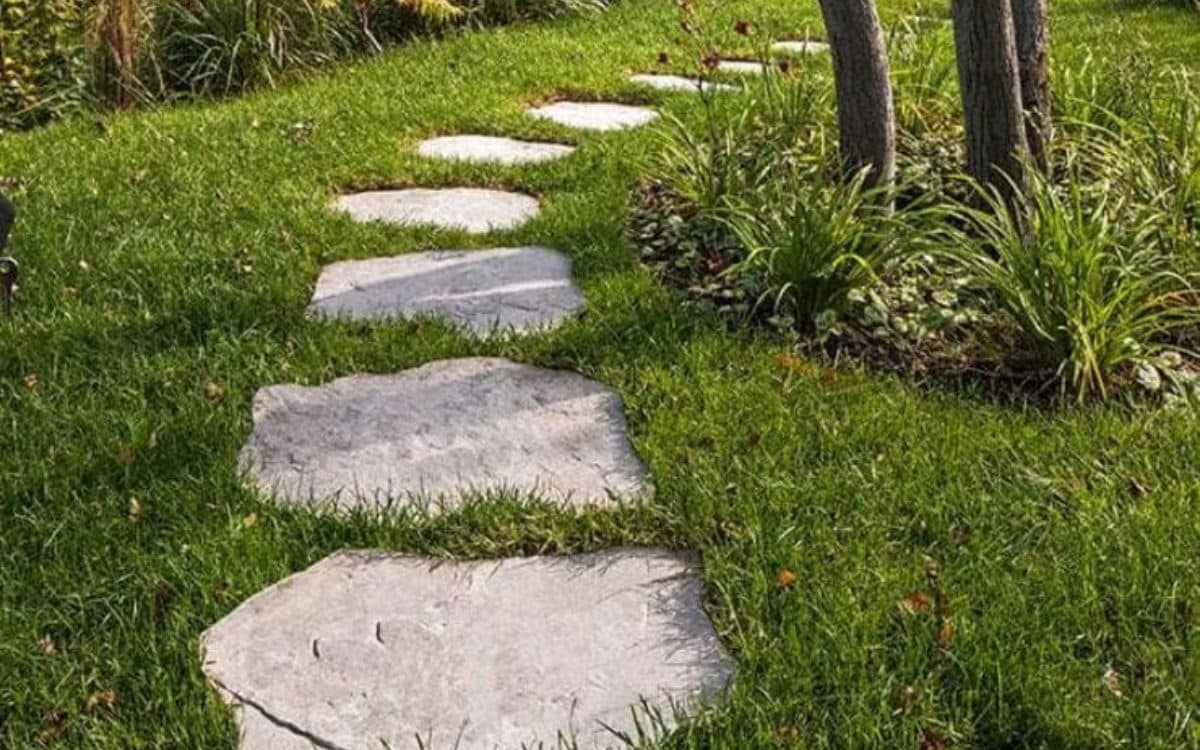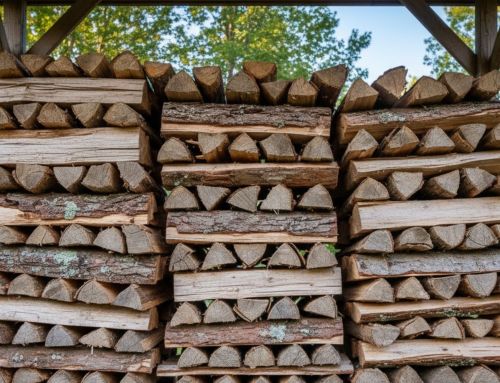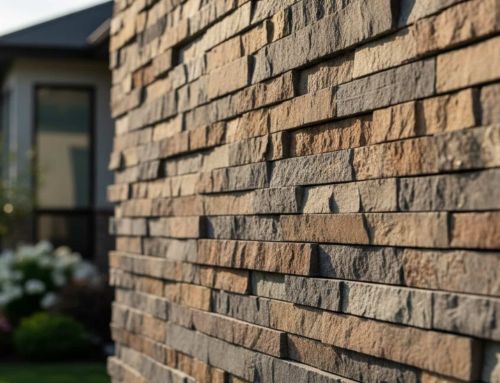Imagine a sunny day in your backyard, where a simple path winds through your garden, leading to your favorite spot to relax with a cup of coffee. Stepping stones can bring that peaceful vision to life, adding charm and purpose to your outdoor space.
Unlike full paving, stepping stones offer a natural way to guide foot traffic while protecting your plants. They are practical, stylish, and easy to install, making them perfect for anyone looking to add beauty and function to their yard.
What are Stepping Stones?
Stepping stones are individual pieces of natural stone, concrete, or other durable materials placed strategically to create pathways through gardens, lawns, and outdoor spaces. Unlike traditional pavers that form continuous surfaces, stepping stones are intentionally spaced apart, allowing grass, ground cover, or decorative materials to grow between them.
The concept has been around for centuries, with people using flat rocks to cross streams and navigate through wet terrain. Today, stepping stones serve both functional and aesthetic purposes for a wide range of individuals, including homeowners, gardeners, and landscape designers. They provide stable footing while maintaining the natural flow of your outdoor space.
Key Features of Stepping Stones:
- Individual placement with gaps between each stone
- Varied sizes and shapes for organic appeal
- Integration with surrounding landscape elements
- Permeable surface that supports drainage
- Flexibility in design and arrangement
Stepping Stones vs. Patio Pavers
Many homeowners wonder about the distinction between stepping stones and patio pavers. While both serve as hardscape elements, they have different applications.
- Size Differences: Stepping stones are typically larger individual pieces (18-36 inches across) that stand alone, while pavers are smaller units (6-12 inches) that fit together.
- Application: Stepping stones excel at creating garden pathways and directing foot traffic. Patio pavers create continuous surfaces for outdoor living areas and high-traffic zones.
- Cost: Stepping stone projects require fewer materials and less site preparation, making them more budget-friendly for pathways.
- Appearance: Stepping stones create a more organic, naturalistic look that blends seamlessly with garden settings.
Types of Natural Stone for Stepping Stones
Choosing the right material is crucial for both longevity and appearance. Each type offers unique characteristics for different applications.
Flagstone
Flagstone remains a top choice for stepping stones. This sedimentary stone splits naturally into flat layers, creating ideal walking surfaces. Its irregular shapes and earthy colors (gray, tan, rust, purple) make each piece unique. Flagstone is relatively affordable and works well for families on various budgets. The natural variation means no two stones are alike, giving your pathway character.
Slate
Slate offers a refined appearance with smooth texture and consistent coloring. Available in gray, green, purple, and black, slate provides excellent slip resistance even when wet. This metamorphic stone offers superior durability and weather resistance. While more expensive than flagstone, slate’s longevity makes it worthwhile for long-term home owners.
Granite
Granite stepping stones offer unmatched durability. This igneous stone withstands heavy traffic, extreme weather, and requires minimal maintenance over time.Granite’s tight structure resists cracking and weathering. It represents a higher investment but can last decades, perfect for high-use areas.
Limestone
Limestone provides a perfect balance between durability and affordability. This stone offers natural slip resistance and neutral tones that complement any landscape. Limestone weathers naturally over time, developing character that many homeowners love. It’s excellent for blending with garden evolution.
Design Ideas for Your Garden Stepping Stone Pathway
Linear Pathways
Straight line stepping stone paths work beautifully in formal gardens or when creating direct routes between key areas like patios, sheds, or seating spots. They offer a clean, organized look that complements structured landscapes. For comfortable walking, space the stones 18 to 24 inches apart, allowing for a natural stride and stable footing.
Curved Walkways
Gently curving pathways create a relaxed, natural feel that invites exploration and adds a sense of flow to your landscape. This design works especially well in garden settings where you want to showcase plantings and guide visitors through different areas without a rigid or formal layout. The soft curves help the path feel like a natural extension of the surrounding environment.
Creative Patterns
- Circular designs for focal points
- Offset arrangements for visual interest
- Mixed materials for eclectic appeal
- Geometric shapes for modern landscapes
Family-Friendly Applications for Children
When children will use the pathway regularly, choose larger stones with textured surfaces. Maintain closer spacing for shorter strides and ensure all stones are level and secure.
If you are involving a child in making or installing stepping stones, use child-friendly tools and always provide supervision. It is important to closely supervise children while they are working with materials like concrete, to ensure safety and help them successfully complete their project.
Benefits of Stepping Stone Walkways for Access
Practical Advantages
- Low maintenance walking surfaces
- Excellent drainage with permeable gaps
- Easy installation for many homeowners
- Cost-effective compared to continuous paving
- Flexible design that can change over time
Safety Features
- Textured surfaces for slip resistance
- Weather-resistant materials
- Stable footing in various conditions
- Durable construction lasting decades
Aesthetic Benefits
- Natural appearance blending with landscapes
- Visual interest and texture
- Plant growth opportunities between stones
- Customizable spacing and arrangement
Installation: DIY vs. Professional
DIY Installation
Many homeowners can successfully install stepping stone pathways. The process involves:
- Planning the route and measuring
- Marking the pathway location
- Excavating 2-4 inches deep
- Adding base material (sand or gravel)
- Placing stones and checking level
- Filling gaps with desired material
When to Hire Professionals
Consider professional installation for:
- Large or complex projects
- Areas with drainage issues
- Integration with existing hardscape
- Heavy stone materials requiring equipment
- Time constraints or physical limitations
Cost Considerations
DIY installation costs mainly include materials and tool rentals, making it a cost-effective option for many homeowners. Professional installation usually ranges from $7 to $35 per square foot, depending on the type of stone and the complexity of the project.
Maintenance and Care Support
Routine Maintenance
- Regular cleaning to remove debris
- Weed control in gaps between stones
- Moss removal for safety and appearance
- Annual inspection for loose or sunken stones
Seasonal Care
- Spring cleaning after winter weather
- Summer plant management between stones
- Fall debris removal to prevent staining
- Winter preparation in freezing climates
Long-term Care
Well installed stepping stone pathways require minimal maintenance and can stay beautiful for years. Simple tasks like cleaning, weed control, and fixing uneven stones help keep your walkway safe and attractive. With proper care, natural stone paths can last for decades without major repairs.
Conclusion
Stepping stones are a practical and stylish way to enhance your landscape without overwhelming it. With the right materials and thoughtful design, they create beautiful, functional paths that blend naturally into your garden or yard. Whether you’re aiming for a simple trail or a standout feature, stepping stones offer a timeless solution that supports both form and function for years to come.
At Old Station Outdoor & Landscape Supply in Norton, MA, our mission is to help homeowners and contractors bring their outdoor visions to life with the right resources and expert support. Visit our showroom to explore a wide selection of natural stone options, and let our knowledgeable team guide you every step of the way. Contact us today and start building a walkway that adds lasting beauty and value to your space.
FAQs
Why are stepping stones important?
Stepping stones provide safe, stable pathways through gardens while protecting plants from foot traffic damage and preventing muddy walkways during the week.
What is the principle of stepping stones?
The principle involves placing individual stones at walking distances (18-24 inches apart) to create pathways while allowing drainage and plant growth between stones, similar to how field stones were historically used.
How do you use stepping stones in a garden?
Place stepping stones to create pathways through garden beds and provide access for maintenance without soil compaction, making gardening more fun and accessible.
Is stepping stone good?
Yes, stepping stones are excellent for creating attractive, low-maintenance pathways that are cost-effective and environmentally friendly, with countless success stories from homeowners and even school landscaping projects.










